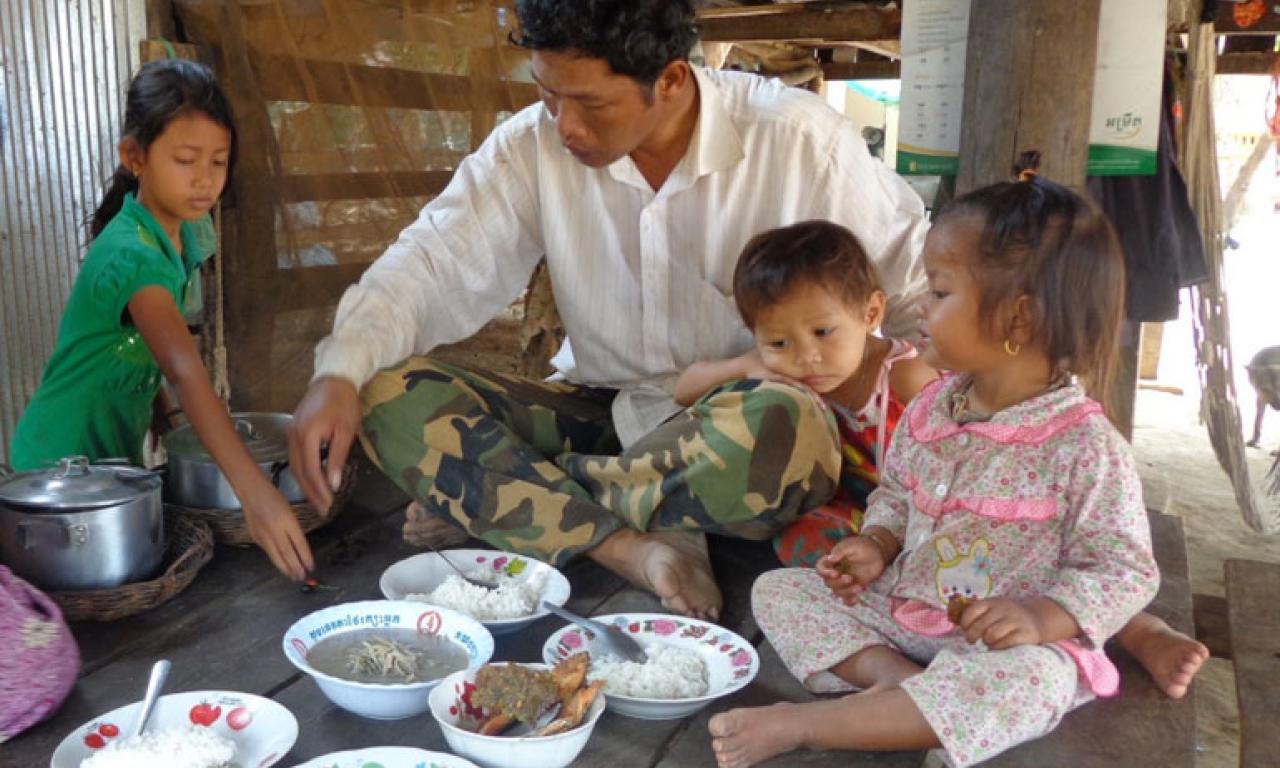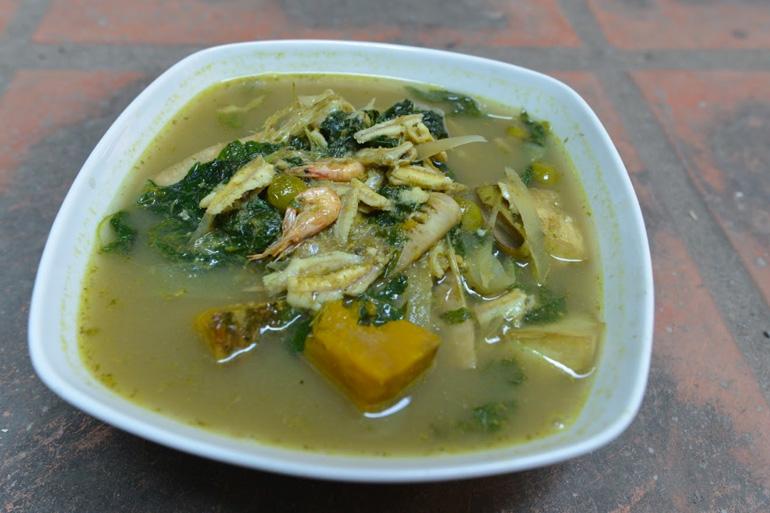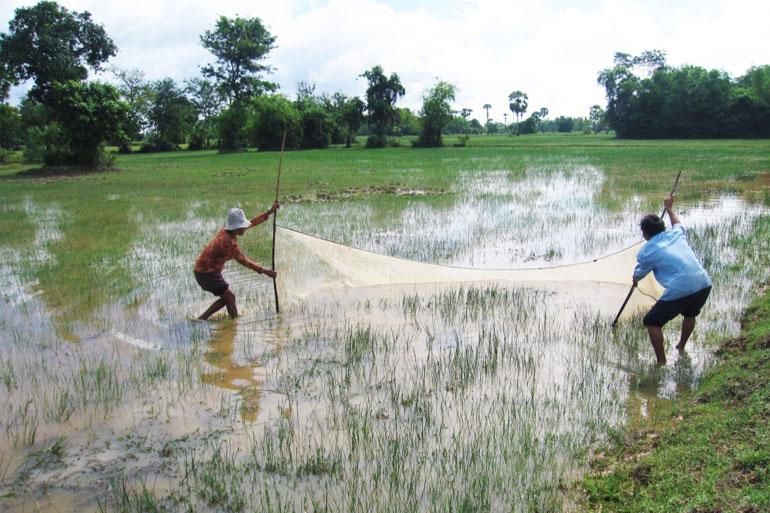
WorldFish’s recipe for Khmer small fish, bean and vegetable stew (samlor kako) – a nutritious and healthy one-pot dish made from common Cambodian ingredients – has won best savory recipe in Feed the Future’s 2016 global contest for the best bean recipes.
Recommended publications
- Fish and the nutrition of rural Cambodians
- Promising practices in food security and nutrition assistance to vulnerable households in the Tonle Sap region, Cambodia
WorldFish’s recipe for Khmer small fish, bean and vegetable stew (samlor kako) – a nutritious and healthy one-pot dish made from common Cambodian ingredients – has won best savory recipe in Feed the Future’s 2016 global contest for the best bean recipes.
In Cambodia, where 80 percent of households engage in fishing, fish is an important diet staple. Fish accounts for 61 percent of households’ animal protein intake each year and is the second most consumed food after rice.
Despite this, consumption of fish by poor women and children is often low. Typically, within a poor household, fish is served preferentially to men and boys before women and girls, who get a much smaller serving size of fish.
This contributes to nutrition insecurity in Cambodia, where 40 percent of children under five are stunted and micronutrient deficiencies, especially iron, vitamin A and iodine, are a major public health concern among pregnant and lactating women and children under five.
A new twist on a classic dish

WorldFish is promoting the samlor kako recipe to encourage women and children to eat more fish, particularly in the first 1000 days of life. Fish, particularly small fish when eaten whole, is a rich source of micronutrients like vitamin A, iron, calcium, zinc and essential fatty acids. These are needed for good health and development, especially in children.
Traditionally, samlor kako, literally translated as stirring soup, is made from freshly-pound spices, fish paste, fish flesh, pork or chicken, and vegetables.
In WorldFish’s twist on the classic dish, the key ingredients are whole small fish, long beans or French beans, and vegetables such as pea eggplant and bitter melon leaves, making it a nutritious one-pot dish. Made thick, the stew can be mashed and fed as a complementary food to young children, starting from six months of age.
Nutritious small fish
The recipe is based around common, small fish species such as the Mekong flying barb, yellow tail rasbora and slender rasbora – which are abundant in the flooded rice fields, rivers and streams that cover the Cambodian countryside.

Often, these wild-caught fish species are rarely eaten by Cambodian households, who perceive that they are only useful for feeding to pigs, ducks and chickens. Some people believe that if small fish is fed to children it will make them thin and susceptible to illness.
WorldFish hopes to overcome these perceptions, by promoting the recipe to show that small fish can be very tasty and nutritious. The recipe also calls for small fish to be cooked whole, which encourages households not to remove the head and eyes – where 53 percent of the small fish’s vitamin A content is – as is common practice.
WorldFish likewise promotes the use of whole small fish in household cooking as part of its USAID-funded Rice Field Fisheries Phase II project, which aims to promote the nutritional benefits of eating fish and increase the productivity of rice-field fisheries.
In phase I of the project (2012–2016), WorldFish promoted the importance and nutritional benefits of small fish by doing trainings, cooking demonstrations and household coaching. These efforts led to a 13 percent increase in at-home consumption of small fish, and boosted consumption of small fish by children under five by 23 percent among households in the project target areas.
Samlor kako recipe
You too can enjoy the flavor sensation of WorldFish’s winning recipe by following these steps:
Ingredients
- 2 tablespoons vegetable oil
- 1 lb. small fish, scaled, washed and cooked whole*
- 1 tablespoon prahok (Khmer fish paste)
- 2 tablespoons tik trei (iron-fortified fish sauce)
- 2 teaspoons palm sugar or light brown sugar
- 1 teaspoon iodized salt (or to taste)
- 4 tablespoons ground toasted rice
- 5 cups water (or fish stock for flavor)
- 3 tablespoons green kroeung, a spice paste (see below for recipe)
- 1 pumpkin wedge (about 7 oz.), peeled, seeds removed, cut into bite-sized chunks
- 1 green papaya wedge (about 7 oz.), peeled, washed, seeds removed and shredded
- 2 handfuls long beans or French beans (about 7 oz.), cut lengthwise into 1 inch pieces
- 2 green bananas (or 1 green plantain), washed then peeled and shredded
- ½ cup trob put-nhorng (pea eggplant), stalks removed, washed and slightly crushed just before using
- 1 small eggplant, washed, trimmed, quartered and cut diagonally into slices ½ inch thick
- 2 big handfuls sleuk ma-raeh (bitter melon leaves) or spinach leaves
*Mekong flying barb, yellow tail rasbora, slender rasbora or any small, firm-fleshed fish may be used.
Green kroeung can be made by mixing and grinding the following ingredients into a paste.
- 3 tablespoons lemon grass leaves, very thinly sliced
- 4 kaffir lime leaves or zest of ¼ kaffir lime
- 1 tablespoon peeled and chopped turmeric roots
- 4 cloves garlic, peeled and chopped
- 4 shallots, peeled and chopped
- 1 teaspoon iodized salt
Directions
- Before preparing this dish, wash hands with soap and clean water. Vegetables must be washed in clean water prior to preparation.
- Heat oil in a large saucepan over medium heat for about 2 minutes. Add the green kroeung then stir-fry for 1-2 minutes until fragrant. Take care that it does not burn. Stir in the fish and prahok, and continue to fry for a further 2-3 minutes until the fish is well coated.
- To prevent the fish from breaking, lower the heat, remove from the saucepan, cover to keep warm, and set aside.
- Turn the heat back up to medium; stir in the pumpkin, green papaya and long beans; and mix well. Pour the water/stock and the roasted ground rice into the mixture. Bring to a boil, and cook for 4-5 minutes.
- Return the fish to the saucepan, add green bananas, crushed pea eggplant and sliced eggplant, and bring back to a boil. Lower the heat slightly and continue cooking with lid on for a further 10-12 minutes or until the vegetables are tender and the fish is cooked through. Stir occasionally to prevent sticking.
- Stir in the bitter melon leaves and remove the saucepan from heat immediately.
Transfer to a serving bowl. Serve hot with steamed rice.